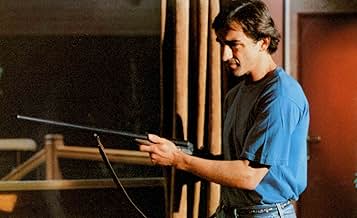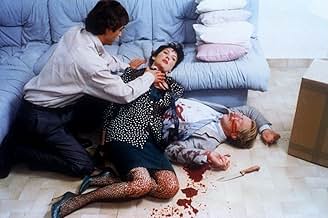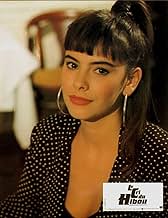Le cri du hibou
- 1987
- 1h 42min
CALIFICACIÓN DE IMDb
6.3/10
1.1 k
TU CALIFICACIÓN
Agrega una trama en tu idiomaAfter separation from his wife Robert moves to Vichy where he observes beautiful Juliette. Her fiance Patrick becomes jealous and attacks Robert. When Patrick disappears Robert is suspected ... Leer todoAfter separation from his wife Robert moves to Vichy where he observes beautiful Juliette. Her fiance Patrick becomes jealous and attacks Robert. When Patrick disappears Robert is suspected to have killed him.After separation from his wife Robert moves to Vichy where he observes beautiful Juliette. Her fiance Patrick becomes jealous and attacks Robert. When Patrick disappears Robert is suspected to have killed him.
- Dirección
- Guionistas
- Elenco
- Premios
- 1 premio ganado y 1 nominación en total
Opiniones destacadas
This Chabrol movie seems to be almost forgotten - given the few comments printed here and given the fact that it's unlikely to be mentioned among the maestros masterpieces. Even though it is based on a novel by Patricia Highsmith, and has some degree of tension in it, "Le Cri du Hibou" doesn't really draw the viewer inside the small world of it's handful of characters. Everyone in this film seems to have his private neurosis, and when fate bonds them all together, an explosive mixture is the result. Unfortunately (and unusually for Chabrol) the narration is not clever enough to tantalize the viewer. Instead, quite a bunch of implausible elements make it hard to enjoy the unfolding of the story. Then again, since it is the story of a man regarded as threat by his surrounding without ever wanting to threat anyone, a man seen as guilty without guilt (or is there guilt at his hands?), Chabrol had to avoid all too much realism. An ultra-realistic view at the same story would stop at 40 minutes; it would not be able to display the ideas driving the characters to their deeds like Chabrol does. Seen through this perspective, the film is quite an interesting statement.
Patricia Highsmith's "cry of the owl" was not her best or even among her best;we are far from triumphs such as "the talented Mister Ripley" "Ripley's game " or "strangers on a train".But it was an interesting psychological study,focusing on a man who thought that, whatever he might do ,he was bound to fall and he would even bring bad luck to his human pals.Like a lot of HIghsmith 's characters ,he was a neurotic,who could not fit in the "normal world" ,with a heavy guilt feeling and a touch of masochism.Chabrol's screenplay is very faithful to the novel,keeping even the last line,but it's a good example of how accuracy leads to failure.
The choice of Christophe Malavoy was excellent because the actor is subtle enough to convey such a despair .But Chabrol put him against a gallery of weirdos who would drive any man insane:a brunette whose behavior is completely implausible,played an unconvincing actress,Mathilda May;a vulgar unattractive wife -Ah Stephane Audran where are you ?- ;a brute of a fiancé who seems even more irrational than the hero,it's the last straw!On the paper the hero's thoughts and frames of mind made up for the implausibilities of the plot and built an atmosphere of ambiguity ,an ambiguity which is almost totally absent in the film,in spite of Malavoy's commendable efforts.To top it all,there's an irritating part of a cop (Kalfon) ,a la Colombo,gobbling up madeleines ,and hinting at Marcel Proust as he tries to remind his unusual suspect of what he may have done.
Because,like in a lot of Chabrol movies,people eat in in "le cri du hibou".The hero and his lady friend treat themselves to some delicious crêpes suzette (flambées) and cassolettes of langoustines:the neurotic is also a gourmet !And he does love the girl's home-made cookies!
Doing two movies a year,Chabrol makes frequently spotty works:such was the case of "le cri du hibou" , deservedly forgotten work,whereas the contemporary "masques " -released at the beginning of the same year- was a brilliant film noir turned almost farce.
The choice of Christophe Malavoy was excellent because the actor is subtle enough to convey such a despair .But Chabrol put him against a gallery of weirdos who would drive any man insane:a brunette whose behavior is completely implausible,played an unconvincing actress,Mathilda May;a vulgar unattractive wife -Ah Stephane Audran where are you ?- ;a brute of a fiancé who seems even more irrational than the hero,it's the last straw!On the paper the hero's thoughts and frames of mind made up for the implausibilities of the plot and built an atmosphere of ambiguity ,an ambiguity which is almost totally absent in the film,in spite of Malavoy's commendable efforts.To top it all,there's an irritating part of a cop (Kalfon) ,a la Colombo,gobbling up madeleines ,and hinting at Marcel Proust as he tries to remind his unusual suspect of what he may have done.
Because,like in a lot of Chabrol movies,people eat in in "le cri du hibou".The hero and his lady friend treat themselves to some delicious crêpes suzette (flambées) and cassolettes of langoustines:the neurotic is also a gourmet !And he does love the girl's home-made cookies!
Doing two movies a year,Chabrol makes frequently spotty works:such was the case of "le cri du hibou" , deservedly forgotten work,whereas the contemporary "masques " -released at the beginning of the same year- was a brilliant film noir turned almost farce.
I had wanted to buy this one for a long time, but repeatedly postponed it due to the excessive price-tag of the DVD and the criticism leveled at the quality of the transfer (which was decent to my eyes even on a 40" TV monitor, if somewhat dark and with the burnt-in subtitles being intrusively large and bafflingly situated towards the middle of the screen!). Anyway, I eventually took the plunge not too long ago and am extremely glad I did – what with the accompanying Audio Commentary alone proving value for money!
The film is a well-regarded effort from Chabrol's middle period, given added prestige by being adapted from the work of celebrated crime novelist Patricia Highsmith. Incidentally, it makes for an excellent example of the director's admiration for Alfred Hitchcock (who had himself brought Highsmith's STRANGERS ON A TRAIN to the screen back in 1951), building suspense and goading the audience into complicity in much the same way as the acknowledged master of the form – though the noir trappings of the narrative (and, by extension, the expressionistic quality of the cinematography here) actually derives from Fritz Lang, another strong influence.
The plot – reportedly, a very faithful rendition of the novel – seems simple enough at first: a slightly disturbed man (about to be divorced) spies on a beautiful neighbor and, when he finally confronts her, realizes that she is herself essentially unbalanced (being willing to drop her current boyfriend and take up with him!); in this regard, the film reminded me a good deal of PRETTY POISON (1968). However, things get complicated when the boyfriend proves both jealous (though the male protagonist never actually consummates the affair!) and violent (even if he has to be saved from drowning himself when the situation comes to a head!), and even more so when the hero's malicious ex-wife becomes involved.
Interestingly, when the boyfriend goes missing, not only is his 'rival' suspected by the Police but, in a delicious reversal of Chabrol's own LA FEMME INFIDELE (1968), the girl rejects rather than endorses him – to the point that she tragically takes her own life (the panoramic shot revealing her lifeless body amid the tall grass is a brilliant touch). Surprisingly, the latter stages turn into outright black comedy as the boyfriend's repeated bungled attempts on the hero's life leave many of those around him lying in a pool of blood – including the boyfriend himself and the ex-wife in the astounding climax (capped by an ambiguous freeze-frame which leaves the protagonist's destiny hanging in the balance).
Another definite asset here is the well-chosen cast: while I was familiar with Mathilda May as the volatile heroine (best-known for playing the nude space vampire of Tobe Hooper's LIFEFORCE [1985] but who also had an important supporting role in Chabrol's recent A GIRL CUT IN TWO [2007]) and vaguely aware of Jean-Pierre Kalfon (portraying the bemused cop on the case), perhaps the most impressive was Christophe Malavoy in the central part (who proving a veritable magnet for disaster likens him with the lead character of Luis Bunuel's delightful 'non-serial killer' black comedy, THE CRIMINAL LIFE OF ARCHIBALDO DE LA CRUZ [1955]!). This analogy is also mentioned in the Audio Commentary featuring one Ric Menello and David Kalat (President of All Day Entertainment, which released the DVD) who provide a comprehensive, scholarly yet entertaining analysis of the film, its tortuous distribution background, as well as a broad look at Chabrol's prolific career.
The film is a well-regarded effort from Chabrol's middle period, given added prestige by being adapted from the work of celebrated crime novelist Patricia Highsmith. Incidentally, it makes for an excellent example of the director's admiration for Alfred Hitchcock (who had himself brought Highsmith's STRANGERS ON A TRAIN to the screen back in 1951), building suspense and goading the audience into complicity in much the same way as the acknowledged master of the form – though the noir trappings of the narrative (and, by extension, the expressionistic quality of the cinematography here) actually derives from Fritz Lang, another strong influence.
The plot – reportedly, a very faithful rendition of the novel – seems simple enough at first: a slightly disturbed man (about to be divorced) spies on a beautiful neighbor and, when he finally confronts her, realizes that she is herself essentially unbalanced (being willing to drop her current boyfriend and take up with him!); in this regard, the film reminded me a good deal of PRETTY POISON (1968). However, things get complicated when the boyfriend proves both jealous (though the male protagonist never actually consummates the affair!) and violent (even if he has to be saved from drowning himself when the situation comes to a head!), and even more so when the hero's malicious ex-wife becomes involved.
Interestingly, when the boyfriend goes missing, not only is his 'rival' suspected by the Police but, in a delicious reversal of Chabrol's own LA FEMME INFIDELE (1968), the girl rejects rather than endorses him – to the point that she tragically takes her own life (the panoramic shot revealing her lifeless body amid the tall grass is a brilliant touch). Surprisingly, the latter stages turn into outright black comedy as the boyfriend's repeated bungled attempts on the hero's life leave many of those around him lying in a pool of blood – including the boyfriend himself and the ex-wife in the astounding climax (capped by an ambiguous freeze-frame which leaves the protagonist's destiny hanging in the balance).
Another definite asset here is the well-chosen cast: while I was familiar with Mathilda May as the volatile heroine (best-known for playing the nude space vampire of Tobe Hooper's LIFEFORCE [1985] but who also had an important supporting role in Chabrol's recent A GIRL CUT IN TWO [2007]) and vaguely aware of Jean-Pierre Kalfon (portraying the bemused cop on the case), perhaps the most impressive was Christophe Malavoy in the central part (who proving a veritable magnet for disaster likens him with the lead character of Luis Bunuel's delightful 'non-serial killer' black comedy, THE CRIMINAL LIFE OF ARCHIBALDO DE LA CRUZ [1955]!). This analogy is also mentioned in the Audio Commentary featuring one Ric Menello and David Kalat (President of All Day Entertainment, which released the DVD) who provide a comprehensive, scholarly yet entertaining analysis of the film, its tortuous distribution background, as well as a broad look at Chabrol's prolific career.
After divorcing his easy wife Véronique (Virginie Thévenet), the designer Robert (Christophe Malavoy) moves from Paris to Vichy. Depressed, he walks for three months to the lawn of the gorgeous Juliette Voland (Mathilda May) during the night to see her cooking. One night, her fiancé Patrick Soulage (Jacques Penot) has traveled, and Juliette meets Robert at the lawn and invites him to drink a coffee with her in her house. Robert visits her again and Juliette has a crush on him. She confides him that she is afraid of death since her brother died when he was eight years old. She dumps Patrick and stalks Robert, and Patrick believes they have a love affair. One night, Patrick forces Robert to stop the car on the road and they fight. Robert leaves the beaten Patrick near the river margin. On the next morning, Patrick disappears, and Robert goes with Juliette to the police to report what happened. But soon Veronique decides to play tricks and gives false information to the incompetent chief of police of Vichy. Soon the personal and professional life of Robert is affected by the accusations of murder, affecting also the life of Juliette that questions whether Robert is guilty.
"Le cri du hibou", a.k.a. "The Cry of the Owl" (1987), is a movie by Claude Chabrol with strange characters in an absurd story. Robert is a shy and weirdo, who meets the gorgeous Juliette without any interest in sex. His attitudes are strange, and he looks like a suspect without any guilt. Juliette is naive and stalks him even when the man says that is not interested on her. Patrick is a sick man, and what he does to Robert is inadmissible. The police of Vichy and the chief of police are incompetent. Véronique is a bit*ch, and in the conclusion, she loses the wealthy Marcello, who is a coward, and has the end she deserves. Suzie is another disgusting character. The usual open end this time does not work. My vote is six.
Title (Brazil): "O Grito da Coruja" ("The Cry of the Owl")
"Le cri du hibou", a.k.a. "The Cry of the Owl" (1987), is a movie by Claude Chabrol with strange characters in an absurd story. Robert is a shy and weirdo, who meets the gorgeous Juliette without any interest in sex. His attitudes are strange, and he looks like a suspect without any guilt. Juliette is naive and stalks him even when the man says that is not interested on her. Patrick is a sick man, and what he does to Robert is inadmissible. The police of Vichy and the chief of police are incompetent. Véronique is a bit*ch, and in the conclusion, she loses the wealthy Marcello, who is a coward, and has the end she deserves. Suzie is another disgusting character. The usual open end this time does not work. My vote is six.
Title (Brazil): "O Grito da Coruja" ("The Cry of the Owl")
M. Chabrol has done a strong, creditable job of transferring the powerfully discomforting world of Patricia Highsmith to the screen. Highsmith's characters become moral monsters through a condition of absolute confidence in their own warped psyches. These characters never learn, or understand themselves. Their lies to each other are absolute because they lie to themselves absolutely. No cliché goes unpunished. Characters become moral monsters without losing their sense of rightness. They seem powerless not to act in self-destructive ways.
The film is not equal to "Strangers on a Train" or "Purple Noon," other adaptations of Highsmith's work. But it is faithful in spirit to a novel which is itself not equal to the literary sources of these films. See it with an open mind and revel in the creepiness. Chabrol is a sufficiently great artist to allow another great artist her night cry.
The film is not equal to "Strangers on a Train" or "Purple Noon," other adaptations of Highsmith's work. But it is faithful in spirit to a novel which is itself not equal to the literary sources of these films. See it with an open mind and revel in the creepiness. Chabrol is a sufficiently great artist to allow another great artist her night cry.
¿Sabías que…?
- TriviaOne of two adaptations of Patricia Highsmith's novel "The Cry of the Owl" that was released the same year, the other adaptation is Der Schrei der Eule (1987).
- ConexionesVersion of Der Schrei der Eule (1987)
Selecciones populares
Inicia sesión para calificar y agrega a la lista de videos para obtener recomendaciones personalizadas
- How long is The Cry of the Owl?Con tecnología de Alexa
Detalles
Contribuir a esta página
Sugiere una edición o agrega el contenido que falta

Principales brechas de datos
By what name was Le cri du hibou (1987) officially released in Canada in English?
Responda



























